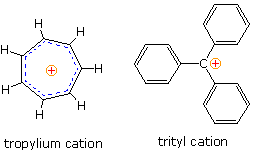


 علم الكيمياء
علم الكيمياء 
 الكيمياء التحليلية
الكيمياء التحليلية 
 الكيمياء الحياتية
الكيمياء الحياتية 
 الكيمياء العضوية
الكيمياء العضوية 
 الكيمياء الفيزيائية
الكيمياء الفيزيائية
 الكيمياء اللاعضوية
الكيمياء اللاعضوية 
 مواضيع اخرى في الكيمياء
مواضيع اخرى في الكيمياء
 الكيمياء الصناعية
الكيمياء الصناعية |
Read More
Date:
Date: 29-5-2017
Date: 29-7-2018
|
Factors Influencing Carbocation Stability
Carbocation intermediates, sometimes called carbonium ions, have been proposed or identified as important species in reactions ranging from electrophilic addition to alkenes, to unimolecular solvolysis of alkyl halides. The relative stability of these cationic intermediates varies markedly with the presence of substituents on the trivalent charged carbon atom, in a fashion that has led useful empirical rules for predicting reaction selectivity (summarized elsewhere). This stability order for simple alkyl alkenyl and aryl substituted carbocations is repeated below, followed by a table of supportive data.
|
|
||||||||||||||||||||||||
A few carbocations, such as tropylium and trityl (triphenylcarbenium) shown on the right, are sufficiently stable to form isolable salts with poorly nucleophilic anions, such as tetrafluoroborate (BF4(–) ). However, most carbocations are unstable and very reactive under normal laboratory conditions, so conventional studies of all but the most stable of these species have not been possible.

Nevertheless, gas phase ionization energies of alkyl chlorides, hydride affinity measurements (gas phase), molecular orbital calculations, and low temperature nmr examination of ionized alkyl halides in mixed solvents composed of SbF5, SO2, SO2F2 & SO2FCl. (referred to as "super acids") have confirmed the qualitative relationship shown above. At low temperatures, 1H and 13C nmr spectra of (CH3)3C(+) and (CH3)2CH(+) were obtained and interpreted. The charged tricoordinate carbon atom exhibited a 13C signal over 300ppm downfield from TMS.



|
|
|
|
دخلت غرفة فنسيت ماذا تريد من داخلها.. خبير يفسر الحالة
|
|
|
|
|
|
|
ثورة طبية.. ابتكار أصغر جهاز لتنظيم ضربات القلب في العالم
|
|
|
|
|
|
|
العتبة العباسية المقدسة تقدم دعوة إلى كلية مزايا الجامعة للمشاركة في حفل التخرج المركزي الخامس
|
|
|